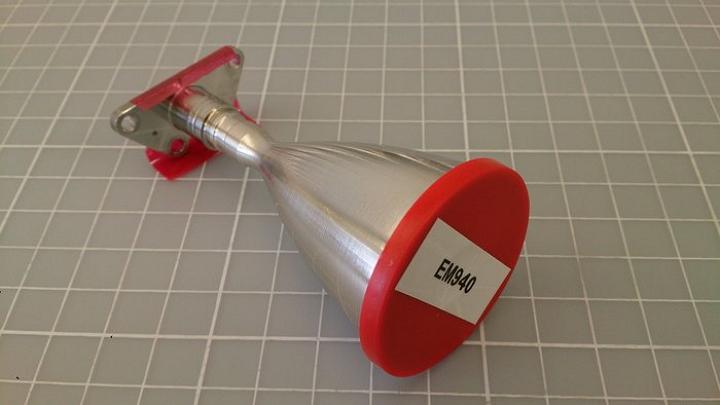 It marks the first time a platinum combustion chamber and nozzle made with 3D printing have been tested under realistic, demanding conditions, and the developers, Airbus Defence & Space, built and tested the prototype thruster in Lampoldshausen, Germany.
It marks the first time a platinum combustion chamber and nozzle made with 3D printing have been tested under realistic, demanding conditions, and the developers, Airbus Defence & Space, built and tested the prototype thruster in Lampoldshausen, Germany.
The build and tests were part of a European Space Agency project dubbed Additive Manufacturing Technologies for Advanced Satellite Thrust Chamber, or AMTAC. The series of firings lasted for more than one hour, going through 618 complete ignition cycles.
Dr. Steffen Beyer, the project manager for the test firings, says the cycle included a continuous burn of 32 minutes. During that test, Beyer says the maximum temperature of 1253°C proved that the 3D printed version of the chamber and nozzle performed in a comparable way to a conventional thruster. “This is a world first,” he noted.
This combustion chamber for the 10 N Hydrazine thruster was printed using a platinum–rhodium alloy.
According to Laurent Pambaguian, who oversaw the project on behalf of the ESA, the project was also a test of the efficiency of 3D printing as a manufacturing method.
“The aim was to test this alternative manufacturing method as a way of reducing material costs,” Pambaguian said. “At the start we were by no means certain it could be done, or even whether the metal powder could be prepared to the appropriate quality. For production we ended up using a laser machine normally employed for making jewellery, which is the current industrial state-of-the-art for manufacturing with these metals.”
Dr. Beyer said material cost savings factored into the plan as well.
“Considering that platinum currently costs €40 a gram, 3D printing offers considerable future savings,” he explained. “We produce 150–200 thrusters in this class per year for different customers, and 3D printing should allow shorter production cycles and a more flexible production flow, such as manufacturing on demand.”
The platinum-rhodium allow powder used to fabricate the chamber and nozzle was supplied by Heraeus and then atomized by Nanoval. The AM process itself used to build the device was overseen by the Fraunhofer Institutes of Laser Technology and Machine Tools and Forming Technology.
“Platinum-rhodium was chosen for this first phase as the most mature platinum alloy for additive manufacturing. In the next phase, we will attempt to print using a new alloy, platinum-iridium, which has performance advantages,” Dr. Beyer said. “This alloy cannot easily be manufactured by traditional techniques like casting and forging, so printing is the only way it can be harnessed for space use.”
The testing and fabricating of the chamber and nozzle combination was part of the long-running Advanced Research in Telecommunications Systems program, ARTES, overseen through the ESA.
Tommaso Ghidini, the head of the ESA Materials Technology section, says the plan calls for the group to move into the use of materials including Inconel and copper which would allow for larger volumes. Ghidini says the Agency’s “to-do list roadmap” was prepared with the participation of industry and the ESA member states and it’s aimed at routinely employ 3D printed parts for space. He said the process includes a variety of qualification and verification procedures.
Have you heard of any other 3D printed aerospace applications which are pushing the boundaries of additive manufacturing? Let us know in the 3D Printed Platinum Combustion Chamber forum thread on 3DPB.com.
Podcast: Play in new window | Download
Subscribe to Our Email Newsletter
Stay up-to-date on all the latest news from the 3D printing industry and receive information and offers from third party vendors.
You May Also Like
3D Printing Unpeeled: New Arkema Material for HP, Saddle and Macro MEMS
A new Arkema material for MJF is said to reduce costs per part by up to 25% and have an 85% reusability ratio. HP 3D HR PA 12 S has been...
3D Printing News Briefs, January 20, 2024: FDM, LPBF, Underwater 3D Printer, Racing, & More
We’re starting off with a process certification in today’s 3D Printing News Briefs, and then moving on to research about solute trapping, laser powder bed fusion, and then moving on...
3D Printing Webinar and Event Roundup: December 3, 2023
We’ve got plenty of events and webinars coming up for you this week! Quickparts is having a Manufacturing Roadshow, America Makes is holding a Member Town Hall, Stratafest makes two...
Formnext 2023 Day Three: Slam Dunk
I’m high—high on trade show. I’ve met numerous new faces and reconnected with old friends, creating an absolutely wonderful atmosphere. The excitement is palpable over several emerging developments. The high...































